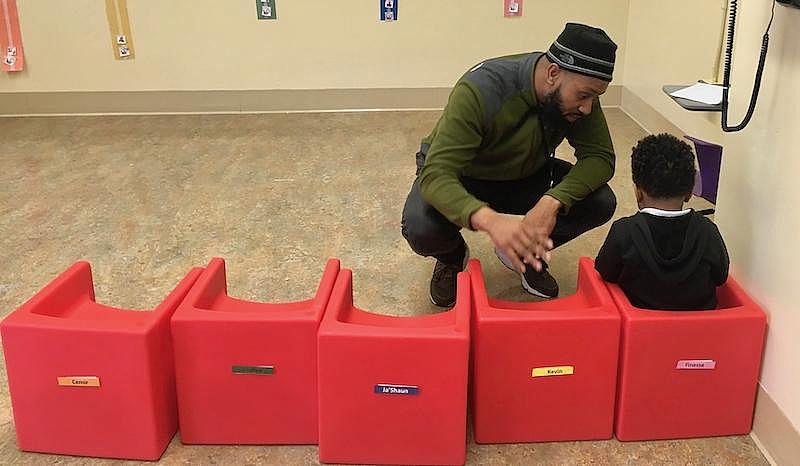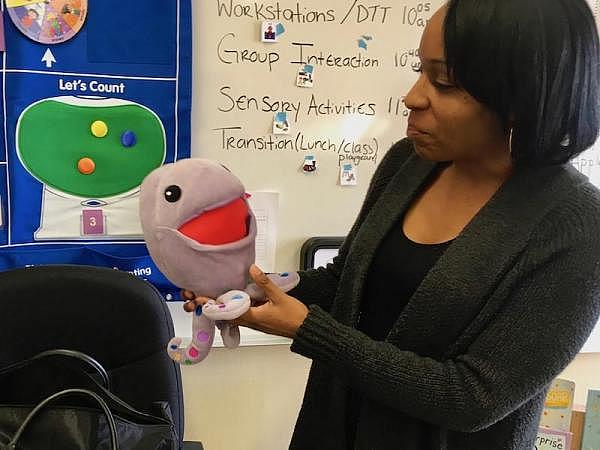SFUSD program intervenes early to keep kids out of special ed for behavior
The series has received support from the Fund for Journalism on Child Well-Being, a program of USC's Center for Health Journalism.
Other stories in this series include:
One African American family, half a century of experience in SF public schools
How can San Francisco support its most vulnerable black residents? Help them succeed at school.
A legacy of mistreatment for San Francisco’s black special ed students
Learning While Black: Community forum
African American honor roll student says when teachers set the bar high, ‘you gotta go get it'
A Landmark Lawsuit Aimed to Fix Special Ed for California's Black Students. It Didn’t.
Lead Plaintiff In Landmark Lawsuit Gets 2nd Chance At Education — At Age 60
A Decade Of Work Leads To Nearly 90 Percent Black Graduation Rate For SFUSD
State Audit Of Program For Homeless Students Finds Undercount, Lack Of Oversight

LEE ROMNEY / KALW
This is part of an ongoing series “Learning while black: The fight for equity in San Francisco schools.”
A new intensive SFUSD program helps kids aged three-and-a-half to five regulate and understand their emotions. The goal: to avert an “emotional disturbance” designation, a special ed category where black children are overrepresented.
The Shoestrings Children’s Center takes up an entire wing of the sprawling Leola Havard Early Education School in the city’s Bayview District. On a winter morning in mid-February, the kids, aged three-and-a-half to five, gather around a low table for a popcorn party.
This isn’t casual snack time. Everything that happens during this 10-week program is intentional, designed to help these little ones learn to control their bodies and emotions. Even the food. Occupational therapist Colleen McNeil, who’s leading this party, selects the snacks and doles them out. Crunchy, chewy, silky. Each helps regulate these kids’ sensory systems, to help them stay alert and focus, or calm down.
The four boys and one girl in this first official cohort know the rules, even if they aren’t always easy to follow: Raise your hand to speak. Take turns. Express your feelings. And always be kind. A behavior interventionist and a couple of interns collect data to help the team track what triggers a meltdown and how the children are progressing socially and emotionally. That data collection is constant here.
Program coordinator Crystal Hawkins passes a container around. If the children do well as a group and fill it up, they get to pick their next special party. They’ve already decided on fruit smoothies. She leans down low and speaks to each kid in clear simple language.
“Can you put in two two marbles?” she asks.
The Shoestrings logo is a pair of bright red high top sneakers, tied together with, yes, shoestrings. Those shoestrings symbolize the program’s collective effort, working not just with the kids but with their families and schools — “tying it all together” as Hawkins says.
“If we're working on taking turns or using language that children understand to get their needs met or even creating a sensory diet,” she explains, “as we're working on these things with your child, we want the family to know so that it can be transferred from the school to home and then from the home to the community.
The program is small, but it’s designed to address an outsized problem. Across the country, black students are steered into special ed for behavior problems at disproportionately high rates. Shoestrings attempts to address their underlying issues before they get that disability designation. The program’s now treating its second cohort, and while it isn’t specifically for black children, district officials say that so far, all but one have been African American. Preschools and kindergartens refer kids here — but only after unsuccessfully trying a bunch of interventions to help them calm down and focus.
When snack time ends, McNeil tells the kids “it’s closed now,” and directs them to put their cups and bowls away. They know the drill.
The goal here, program architects say, is to create a safe and nurturing environment for the kids, and a huge part of that is making their three hours here every weekday morning as predictable as possible, because not knowing what comes next can cause anxiety. Color-coded visual schedules help kids understand exactly what they’ll be doing during their 30-minute blocks and in what order, but switching from a fun activity to a less fun one can still be tough.
Shoestrings program coordinator Crystal Hawkins shows off "Huggtopus," a plush toy in the Kimochis series. Kimochis (which means "feelings" in Japanese) come with a curriculum to help kids better deal with difficult feelings and challenging behaviors. (CREDIT LEE ROMNEY / KALW)
A four-year-old named Cemir crawls onto the snack table on all fours. He’s having a hard time transitioning, and that’s common. Hawkins asks him: How will I know you’re ready? Because here at Shoestrings, staff will wait as long as it takes. They never tell a child ‘no,’ either. Instead, they’ll say an activity is “not available” and offer two choices. The point of all this is to give the kids agency.
“Right now, you can go and check your schedule or you can take a break in the peace corner. What would you like to do?” Hawkins asks Cemir, squatting next to him to look him in the eye.
Cemir tells her he wants to “go with mommy,” but mommy’s at work right now, Hawkins explains, reminding him again that he has options. He agrees to head to the peace corner, where the Shoestrings nurse, Josh Trenter, has an interactive game ready.
“This monster’s also having a hard time calming down,” Mr. Josh explains, and you can help him calm down by touching his tummy to help him take deep breaths.”
Hawkins suggests they all take one together. As Cemir fondles the touch screen, they breathe in time with the teal-blue monster. It slows Cemir down, and helps him understand that he can control his body.
“The monster is calming down!” a high-pitched voice reports from the video screen. “Much calmer!”
Hawkins leaves Cemir with Mr. Josh to settle down. Then she takes a three-and-a-half year old named Kevin down the hall to his next 30-minute block.
This is one-on-one special playtime. Family members come to participate, too, getting prompts in an earpiece from a therapist behind one-way glass, but today Hawkins is Kevin’s playmate. He picks out a playground set and they unpack it together.
“Do you need help?” Hawkins asks — because teaching kids to ask for help is key to their success back at school and out in the world. “With the mom and daddy and the brother and the sister,” Kevin answers.
Some kids here have been exposed to violence in their neighborhoods. Some come from families that have struggled with instability. To help them feel calmer and more grounded in their bodies, the Shoestrings occupational therapist guides them as they play in a sensory room filled with swings, balls and climbing structures.
Special playtime can also help the kids work through anxieties. Taking the “brother” toy in his hand, Kevin asks Hawkins if she has a son. She tells him she doesn’t. So he asks a follow-up question: “Your son in jail?”
Hawkins is playing the mommy, and models the use of kind language. “Do you need me to catch you?” she asks. He does.
“Was she using kind words to her son?” she prompts Kevin, asking him to think of some “other kind words that her son could tell her.” Kevin ponders before answering. “Go get in the car,” he suggests. They discuss.
Kevin’s doing great, until all of a sudden, he melts down.
“I don’t need nothing!” he yells at Hawkins, trying to crawl away. “Leave me alone!”
There’s 15 minutes left in the session but Hawkins can wait. Kevin accidentally elbows her hard in the lip. She takes his shoes off to avoid hard kicks. She holds him close, walking him through the program’s calming tricks.
Shoestrings is a collaboration of school district’s early education, student, family & community support, and special education departments, along with the city’s department of public health. It’s modeled after a clinic run by the Desert Mountain Children’s Center, in San Bernardino County’s Apple Valley. Solano and Fresno counties have also modeled similar programs after that clinic. The director told me they don’t track whether participants stay out of special ed. But, she said, follow-up stats show every child comes out of the clinic with an improved ability to self-regulate. The key to success — there and at Shoestrings in San Francisco — is for schools and families to keep the interventions going after the program ends.
Cordeila Hampton’s son was one of three kids who took part in a pilot of the Shoestrings program here last summer. Hampton is 25 years old and a single mom, with a full time class schedule at City College. She juggles a bunch of jobs and needs the support.
“I can relate to everything they saying because the same thing they going through here, I go through at home,” Hampton says during a visit to Shoestrings. “So it was just like, alright, they helped.”
Hampton says she keeps a visual schedule on the wall at home for her son and has adopted other Shoestrings practices too. She organizes his toys in a box the same way they do at school, to make his “scenery” predictable, and keep calming tools like his Play-Doh, easily accessible.
“They know more about him that I don’t know,” she says, “so they’re helping me learn more about my own child because I’m still balancing everything.”
Hampton says she wishes her son could have stayed in Shoestrings. He’s now in Kindergarten and has difficult days. But the program is a short-term intervention for the neediest kids only: ten intensive weeks, five kids at a time, at a cost, district officials say, of $1.4 million a year. It sounds a bit like trying to put out a wildfire with a silver teaspoon, but the Shoestrings team is testing out what works, and taking that information back to the kids’ classrooms. The hope is that those teachers start to apply the techniques with all their students.
The district’s director of special ed also says she wants to see the program expanded — to more kids, slightly older kids, and kids who are already designated with special needs. As for parents, Hampton tells me Shoestrings staff is still always there when she needs them.
Hawkins and behavior interventionist Marcus Bundy — an African American man who Hampton says became a kind of father figure to her son — are always just a text or a phone call away. And she isn’t shy about asking them for help, “like a 911 emergency,” she says, laughing.
Graduation for the first official cohort takes place on a sunny Thursday in late March. Mothers and one dad filter in to take their seats, along with some Bayview educators and district officials. There’s cake and a tour, but first there’s a song.
“Hello, hello, hello and how are you. I’m fine. I’m fine. I hope that you are too,” the kids sing with help from Bundy, the behavior interventionist. The staff are sporting red converse sneakers — like the ones in the Shoestrings logo — and they along with the kids have donned their Shoestrings T-shirts. After the children show off a dance, each is called up with his or her family to get a certificate.
How these children do long-term, and how widely schools embrace the Shoestrings approach, that will be the program’s true test. But every parent and grandparent in the room tells me they’re grateful.
[This story was originally published by KALW.]

